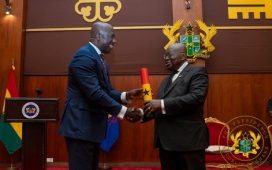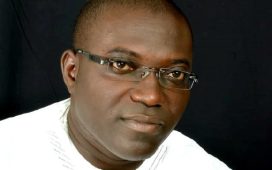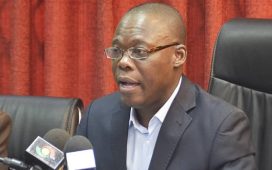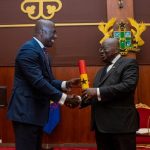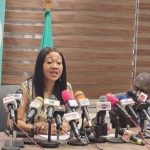As part of his birthday Anniversary, President of the Millar Institute for Transdisciplinary and Development Studies Professor David Millar who also doubled as an old student of Navrongo Senior High School have put up a ‘draft concept paper’ for what he called a Novel Approach to Teaching and Learning in Secondary Institutions in Ghana
Problem-Based Learning (PBL) in Navrongo Senior High School (NAVASCO).
According to Professor Millar, “The records show that University for Development Studies, Tamale was first to introduce PBL in her Medical Programs in Ghana, and University of Cape Coast, Cape Coast, was first to do likewise in a Social Science Programs. The same records show that PBL is alien to Secondary Institutions”.
“The public have bemoaned the education standards in the country and the general perception is that they are following along with the fact that they are not relevant for purpose. A clarion call from stakeholders but especially from the Education Minister during his recent visit to the UN Submit (September 2022) added to the need for proactive strategies to salvage Ghana’s Education”.
He said: “In sharing with these concerns the Old Students Association of Navrongo Senior High School (NABIA), is attempting at heeding the call by all a sundry to come out with innovations to help salve her Alma Mata”.
Meanwhile, as part of his birthday anniversary, Profession David Millar presented the concept paper to the school management and staff of her Alma Mata NAVSACO.
Apexnewsgh.com can confidently report that the management of the school was extremely excited when the draft concept paper was presented to them by astute Professor Millar, as they immediately requested for urgent implementation of the concept.
Kindly read the full concept below
PROBLEM-BASED LEARNING (PBL) IN NAVRONGO SENIOR HIGH SCHOOL (NASVASCO)(DRAFT CONCEPT PAPER)
PUT TOGETHER BY PROF. DAVID MILLAR
OCTOBER, 2022
PROBLEM-BASED LEARNING (PBL) INTRODUCED IN NASVASCO: A NOVEL APPROACH TO SECONDARY TEACHING AND LEARNING IN GHANA
1.0 Prelude
Problem-Based Learning (PBL) at the Second Cycle Institutions Level is not new in the Advanced Countries but it is relative new in Africa; and in Ghana not known to be practice anywhere at the Secondary Levels. This approach to teaching and learning is very prominent at various Medical Schools the world over. The records show that University for Development Studies, Tamale was first to introduce PBL in her Medical Programs in Ghana, and University of Cape Coast, Cape Coast, was first to do likewise in a Social Science Programs. The same records show that PBL is alien to Secondary Institutions.
Recent events in the Education Programs in Ghana has given rise to a need for major reforms towards emphasis on TVET and Hands-on Education for various educational offerings.
The public have bemoaned the education standards in the country and the general perception is that they are following along with the fact that they are not relevant for purpose. A clarion call from stakeholders but especially from the Education Minister during his recent visit to the UN Submit (September, 2022) added to the need for proactive strategies to salvage Ghana’s Education.
In sharing with these concerns the Old Students Association of Navrongo Senior High School (NABIA), is attempting at heeding the call by all a sundry to come out with innovations to help salve her Alma Mata.
Hence, the Old Students Association, with her own voluntary contributions, mobilized from Old Students Local and International have offered to launch the PBL program at NAVASCO, in collaboration with GES, the School Authorities, PTAs, and the Student Body. This will be organised first as an ICT-Science Club for PBL (starting with Biology, Chemistry, and Physics as pioneer courses). The experiences from this experiment, if impactful, will then be expanded to other programs of learning.
2.0 What is Problem-Based Learning (PBL)?
(This is sub-chapter is extensively from literature)
The term “Problem-Based Learning” (PBL) was originally developed by Barrows and Tamblyn (1980) for Medical Education. It is based on the Constructivist Theory of Learning.
PBL is a pedagogical strategy that uses open ended / ill-structured problems that mirror real-world problems. The authenticity of the problems helps students to transfer their knowledge and skills beyond the classroom, preparing them for the workplace and life in a rapidly changing world. The open ended nature of problems gives students the flexibility to approach it from different angles, to take different thematic sidelines according to their personal interests. This gives them control of the learning process, capturing their interest and motivating them to learn.
Lewis et al. (1998) emphasises that the act of posing problems is integral to the process of solving problems. Finding or posing problems is a creative endeavour that can occur prior to, during, or after the act of problem solving. By keeping the problem definition open, the students can “frame and reframe” their perspective on a problem so they reach “goal clarity”. Educational psychologists have discovered that solving a problem is a back-and-forth (recursive) process, not a linear one (Pea, 1985). In this way the student takes ownership of the problem thus enhancing their engagement and responsibility for the learning process.
Suggested principles of PBL (Slavery and Duffy, 1995)
• Anchor all learning activities to a larger task or problem.
• Support the learner in developing ownership for the overall problem or task.
• Design an authentic task.
• Design the task and the learning environment to reflect the complexity of the environment they should be able to function in at the end of learning.
• Give the learner ownership of the process used to develop a solution.
• Design the learning environment to support and challenge the learner’s thinking.
• Encourage testing ideas against alternative views and alternative contexts.
• Provide opportunity and support for reflection on both the content learned and the learning process.
• Gudzial et al. (1997) consider the two most important aspects of Problem-Based Learning to be the authentic real world problems and students reflection on their experiences.
• The teacher’s role changes from the provider of content to the facilitator of the learning process. Teachers present students with authentic problems and provide an environment where students can explore their ideas through research, discussion and reflection. The student has an active role identifying and locating resources, gathering and evaluating information.
What are the steps in PBL?
- Develop a problem
- Activate existing knowledge
- Identify required knowledge
- Research
- Assess
- Share solutions
- Reflect and compare
- Critically analyse
What is the advantage of PBL?
Problem-based learning immerses learners in real-world problems, fostering the development of key skills such as critical thinking, metacognitive skills, creativity and innovation.
Through problem-based learning, learners develop:
• Analytical thinking and innovation
• Active learning and learning strategies
• Creativity, originality and initiative
• Critical thinking and analysis
• Complex problem-solving
What are the characteristics of PBL?
The four characteristics of problem-based learning are: - Authentic: use real-world, relevant problems that are meaningful to learners.
- Personalised: Personalise learning, connecting with learner individual styles and creativity.
- Non-linear: Learners work in multiple directions and explore diverse avenues, theories, ideas and solutions.
- Guide and scaffold: Steer learners in the right direction using prompting questions and provide resources.
What are the roles of the Teacher in PBL?
The role of the teacher in problem-based learning is to:
• Guide and support learners to actively construct their own learning, as opposed to providing information to passive receivers
• Allow learners to take the lead, and scaffold by observing, noticing, reflecting and responding
• Personalise learning, connecting with learners’ individual styles and creativity, and providing opportunity for extension
• Allow learners to work in multiple directions, guiding students through questioning
• Implement multifaceted assessment through meaningful, ‘connected’ contexts throughout a program
3.0 What are the Intrinsic Benefits?
• Introducing Actors to Hands-on Problem Resolution Based learning (PBL).
• Emphasising on applications of science so acquired in resolving pertinent societal problems.
• With the use of ICT and other forms as source materials, compelling students to start early learning how to conduct research.
• This will be giving a conjoint learning opportunity for Staff and Students simultaneously.
• Students will learn Self-study very early in their academic lives.
• We will, by so doing, give the students a head-start on how to work in a Multidisciplinary manner since the reality is that life and living after school is a Multidisciplinary endeavour.
4.0 How will it be organised at Navasco?
• Syllabus-based Praxis Assignments – linking theory to practice and to simulated realities.
• Focusing on Final Year Students of Biology, Chemistry, and Physics.
• Enhance the knowledge and skills of Staff who will be running such programs (they would be the first points of call in tackling the problem so identified.
• Students will be organised in groups of, say, 10, to undertake assignments.
• The assignments, as much as possible, will require cross-discipline solutions (cutting across Biology, Chemistry, and Physics, and common sense).
• They will be ICT-BASED for researching and applications.
• On average 3 such sessions will be organised per term making a total of 9 in a year.
• Each assignment per group of 10 will be examined and given marks. At the end of one term. The average of the 3 assignments will determine which Group is first, second, or third.
• Reward Systems will be introduced to appreciate achievements and motivate students.
• There will also be a concurrent Reward System for Teachers involved in the exercise.
• The most significant reward, besides knowledge and skills, will be giving Students very early start on how to collaborate and work in teams: learning from the challenges thereof (including the management of riders and fence sitters), to produce a deliverable.
• This program will be evaluated at the end of every year and reviewed for enhancing.
• The durations will be determined by the exigencies of the situation.
• Dedicated Seed Money will be from Voluntary Contributions from NABIA.
• Other contributions from stakeholders motivated by this singular effort will be welcomed (including that from PTA, and even the School, resources permitting).
5.0 How will PBL be a Sustainable Innovation?
• The involving of the School’s Stakeholders, right from the beginning is to ultimately count on continuity therefrom.
• NABIA is opened to other Secondary Institutions, in fact, GES her self’s preparedness to Pilot elsewhere or make it a Test National Program; emerging from the pioneering work and experiences of NABIA, and of NAVASCO.
• The public domain; mindful of the fact that it is not an Exclusive or a Walled- Innovation.
6.0 Who will be the Ultimate Beneficiaries?
• The students aspiring for Medical Programs at the Tertiary level.
• Africa and the World at large.
• Ghana in particular.
• Human capacities in general
References
• Jonassen, D.H. Howland, J., Moore, J., Marra, RM. (2003) Learning to solve Problems with Technology. A Constructivist Perspective
• Lewis, T., Petrina, s. and Hill, A. M. (1998) Problem Posing-Adding a Creative Increment to Technological Problem solving. Journal of Industrial Teacher Education, Vol 36 No 1 Fall 1998. Retrieved from http://scholar.lib.vt.edu/ejournals/JITE/v36n1/lewis.html on 23 March 2007
• Riel, M. (2000) New designs for connected teaching and learning. White paper for US Department of Education Secretary’s Conference on Educational Technology. Retrieved fromhttp://www.gse.uci.edu/mriel/whitepaper/learn1.html
• Guzdial,M., Hmelo, C., Hübscher,R., Nagel,K., Newstetter,W., Puntambekar,S., Shabo,A., Turns,J. and Kolodner,J.L. (1997) Integrating and Guiding Collaboration: Lessons Learned in Computer-Supported Collaborative Learning Research at Georgia Tech. Presented at Conference on Computer Supported Collaborative Learning, 1997. Retrieved from http://www.oise.utoronto.ca/cscl/papers/guzdial2.pdf 6 Nov 06
• Slavery, J. R. Duffy, T. M. (1995) Problem-Based Learning: an instructional model and its constructivist framework. EDUCATIONAL TECHNOLOGY -SADDLE BROOK NJ- 1995, VOL 35; NUMBER 5, pages 31 Retrieved from http://www3.uakron.edu/edfound/people/savery/papers/sav-duff.html on 20 March 2007
By: Prof. David Millar
MITDS, Box 607, Bolga.
millarad1@yahoo.com/
millarazy@gmail.com
0244 720834/ 020 3210740
(December, 2022)
BUDGET:
- 3RD Ghs 100/ 2nd Ghs 200/ 1st Ghs 300.
- Teachers: Physics Ghs 300/ Chemistry Ghs 300/ Biology Ghs 300.
- Total Per Term = Ghs 1,500.
- For the year (3 Terms) = Ghs 4,500





